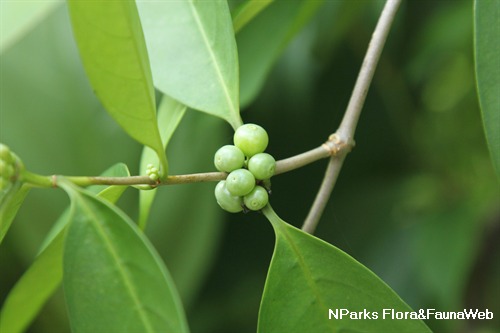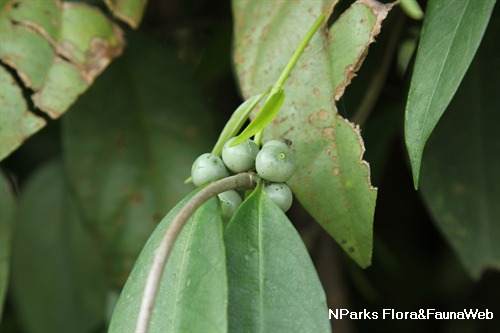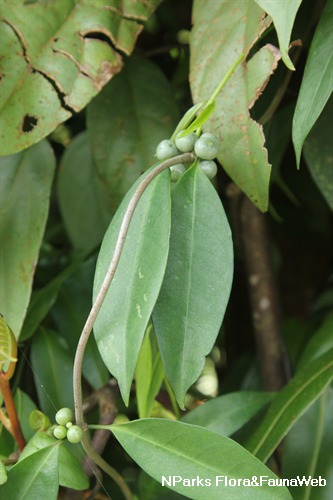
Back
Gynochthodes coriacea Blume
| Family Name: | Rubiaceae |
| Synonyms: | Gynochthodes sublanceolata Miq., Paederia tetrandra Wall., Gynochthodes tetrandra Kuntze |
| Common Name: | Akar Lampai Hitam |
Name
Classifications and Characteristics
| Plant Division | Angiosperms (Flowering Seed Plants) (Dicotyledon) |
|---|---|
| Plant Growth Form | Climber |
| Lifespan (in Singapore) | Perennial |
| Mode of Nutrition | Autotrophic |
| Plant Shape | Irregular |
Biogeography
| Native Distribution | Peninsular Thailand, Peninsular Malaysia, Singapore, Sumatra and Borneo. |
|---|---|
| Native Habitat | Terrestrial (Primary Rainforest, Secondary Rainforest) |
| Preferred Climate Zone | Tropical |
| Local Conservation Status | Native to Singapore (Least Concern (LC)) |
Description and Ethnobotany
| Growth Form | It is a slender woody climber. |
|---|---|
| Foliage | Its stalked leaves have thinly leathery leaf blades that are oval-lance-shaped, dark green, and 5.6–8.1 by 1.3–2.8 cm, with 5–6 pairs of veins. |
| Flowers | Its flowers are few and grow on very short axillary branches. Its petals are white. |
| Fruit | Its fruits are round, greyish, and 1.3 cm in diameter. |
| Habitat | It grows in primary and secondary forests, typically in bright, open areas. |
| Associated Fauna | Its flowers are insect-pollinated. The fruits are probably dispersed by birds. |
| Cultivation | It can be propagated by seed. |
| Etymology | Greek gynochthodes, bank-like ovary; Latin sublanceolata, almost lance-shaped, referring to the shape of the leaf blades |
| Ethnobotanical Uses | Medicinal: A decoction from the leaves and roots is administered to cure stomachache. |
Landscaping Features
| Landscaping | It is suitable for growing on trellises and pergolas in parks. |
|---|---|
| Desirable Plant Features | Ornamental Fruits |
| Landscape Uses | General, Parks & Gardens, Small Gardens, Trellis / Arbour / Pergola |
Fauna, Pollination and Dispersal
| Fauna Pollination Dispersal Associated Fauna | Bird-Attracting |
|---|---|
| Pollination Method(s) | Biotic (Fauna) |
| Seed or Spore Dispersal | Biotic (Fauna) |
Plant Care and Propagation
| Light Preference | Full Sun, Semi-Shade |
|---|---|
| Water Preference | Moderate Water |
| Rootzone Tolerance | Moist Soils, Well-Drained Soils, Fertile Loamy Soils, Easy to Grow |
| Propagation Method | Seed |
Foliar
| Foliage Retention | Evergreen |
|---|---|
| Mature Foliage Colour(s) | Green |
| Mature Foliage Texture(s) | Leathery, Thin |
| Foliar Type | Simple / Unifoliate |
| Foliar Arrangement Along Stem | Opposite |
| Foliar Attachment to Stem | Petiolate |
| Foliar Shape(s) | Non-Palm Foliage (Oval, Lanceolate) |
| Foliar Venation | Pinnate / Net |
| Foliar Margin | Entire |
Floral (Angiosperm)
| Flower & Plant Sexuality | Bisexual Flowers |
| Flower Colour(s) | White |
|---|---|
| Flower Grouping | Cluster / Inflorescence |
| Flower Location | Axillary |
| Flower Symmetry | Radial |
Fruit, Seed and Spore
| Mature Fruit Colour(s) | Green - Light Green |
|---|---|
| Fruit Classification | Simple Fruit |
| Fruit Type | Fleshy Fruit , Non-Accessory Fruit |
Image Repository
Others
| Master ID | 31776 |
|---|---|
| Species ID | 6176 |
| Flora Disclaimer | The information in this website has been compiled from reliable sources, such as reference works on medicinal plants. It is not a substitute for medical advice or treatment and NParks does not purport to provide any medical advice. Readers should always consult his/her physician before using or consuming a plant for medicinal purposes. |





